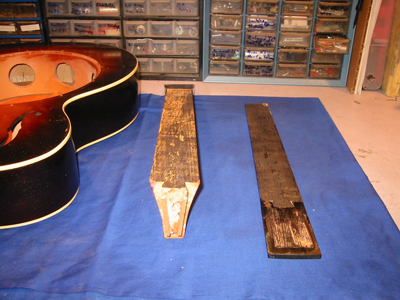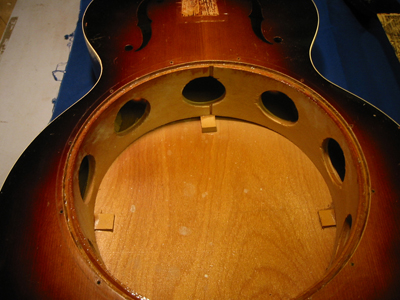1930’s Gibson L-5
On these
pages
When this 1930’s Gibson L-5 was presented to me, it was a perfect candidate for a “restoration.” The guitar has been smashed at some point in the 1950’s, with its face broken. It had been poorly repaired, with the original finish removed, the crack plugged, and an opaque finish and then a badly-done sunburst applied. At first glance, one would have taken it for a cheap mass-produced instrument. It had also been water-damaged , a block was missing from the fret board, and the binding was coming off. All of these problems resulted in a poor sound quality.
The owner, whose father had played this guitar decades earlier, was eager to see it returned to its well-deserved beauty as a fine instrument, and I found it to be a rewarding challenge.
I stripped the many layers of varnish and opaque
finish, to determine how to best repair the broken top.
I made a custom jig (shown at the right) to cut a perfect channel
all the way down to the binding from the end of the neck, about 1” wide
and not all the way through the top.
The precision was in the .001” range.
Then I inlaid a perfectly matched piece of
The tool at the left is a Laminate router, spinning at 14,000 rpm. The bit used was a ¼” carbide straight flute bit. It took three passes to a depth of .038” to create the channel.
After the inlay, I replaced the frets and finished the guitar with a sunburst, as shown on the home page of this site.
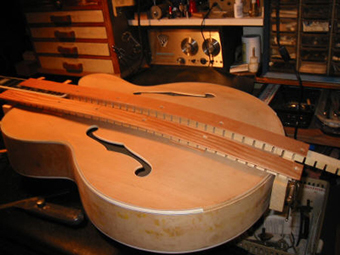
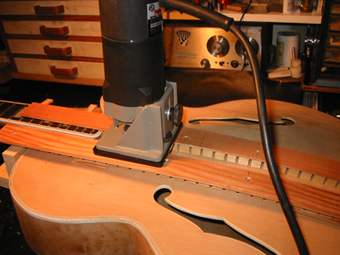
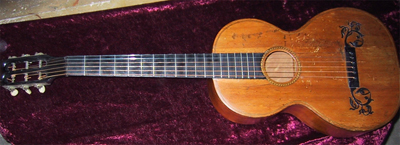

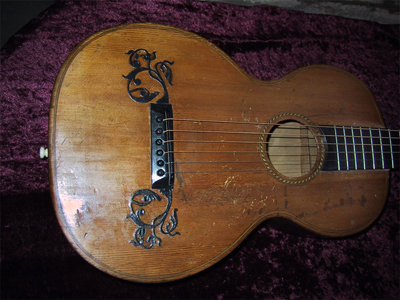
1865 No-name
This 1865 “no-name” is probably a very early Sears catalog item. The owner wanted it restored because it had been in her family since the time of the Civil War, when it was reputed to have been carried in battle.
The original shellac, which you see in the post-restoration photo at the right, was under many coats of varnish, paint, and dust. I was able to scrape it down and leave only the original finish. I also re-set the neck and installed new frets.
I don’t usually build custom cases for instruments but I felt this old guitar deserved one because no off-the-shelf case would do it justice. The instrument is small, even smaller than a “parlor” guitar, and the head stock has an extreme angle. The case I built will provide a relatively stable environment for temperature and humidity, as well as protecting the instrument otherwise.
1930’s Dobro
This 1930’s Dobro, shown at right, was in perfect condition except that it was strung up tight for 50 years and shoved in a closet somewhere. This pulled the neck and fingerboard up to such an extent that the strings were about an inch off the end of the fingerboard.
I love these old Dobros, and especially the fact that they were built to be worked on. Hide glue in the neck joint (dovetail) meant that the neck very nicely popped right out, given the proper heat and force applied in just the right way. Removing the fingerboard from the neck was a bit more complicated, but again the hide glue that had been used made it respond to just the right amount of heat.
There is a lot of controversy about why a Dobro sounds like a Dobro. Is it the weight of the cone? Is the spider versus the National style ______ compression of the cone? Is it the metal body versus the wood body? As with all instruments a characteristic sound is caused by a myriad of different forces and materials that are hard to quantify.
The Dobro’s sound is a perfect example of the whole being greater than the sum of its parts. It was a sad day indeed when this instrument left the shop.
